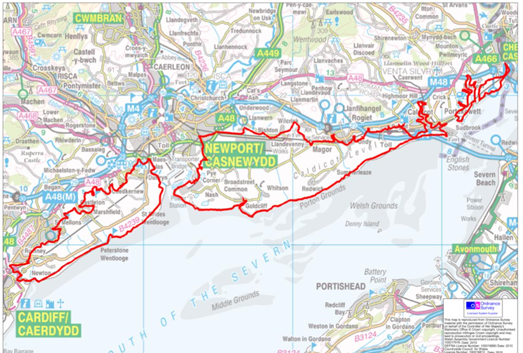How our Internal Drainage District (IDD) team manage the Gwent Levels
Overview
Click here to view this page in Welsh
Caldicot & Wentlooge
The Gwent Levels are a historic landscape of international significance that are characterised by a complex network of fertile fields and historic water courses (known locally as reens) that stretch across 180Km.
Home to seven Sites of Special Scientific Interest (SSSI) that make up approx. 57Km of the area, the Levels are maintained through careful water level management which requires assent. A list of the SSSI locations on the Levels can be found below:
- Rumney & Peterstone
- St. Brides
- Nash & Goldcliff
- Whitson
- Magor & Undy
- Redwick & Llandevenny
- Magor Marsh
Our role – management of the reen network
At Natural Resources Wales (NRW) our Internal Drainage District (IDD) team are responsible for managing approximately 105km of the water courses and drainage channels that cross the Levels, which are controlled by a combination of 229 tilting weirs, penstocks and boarded sluices.
To ensure we are carrying out the work as effectively as possible, our IDD team have an annual construction programme, to carry out vital maintenance work which includes:
- Upgrading existing structures
- Fitting new weirs and penstocks
- Installing culverts
- Repairing, reprofiling and stabilising water banks using timber staking techniques, which have been used on the Levels for a number of years and ground anchor techniques outside of SSSI.
Please note, from October 2023, sea outfall inspections will be managed by our south east integrated engineering workforce team.
Maintenance work
Below is a summary of the maintenance work that is scheduled to be carried out on the reens over the next few months.
Please note this is subject to change. We will update this every quarter – please keep an eye on this project page and our social media channels (@CyfNatCymDD) for more information:
Maintenance work for current quarter (March -May)
- Mowing
- De-weeding and de-silting outside of SSSI
- Water level management, including adjusting the Summer Penning levels to help manage flood risk (see below for further details)
- Litter picking following de-weeding and de-silting operations
Map of the IDD boundary

Minimising flood risk
The water levels on the Gwent Levels, are controlled and maintained by our IDD team by adjusting the weirs, penstocks & sluices seasonally and by monitoring weather forecasts, taking a reactive approach. The seasonal adjustments are known as Summer Penning Levels (SPL) and Winter Penning Levels (WPL) which essentially requires maintaining high water levels during summer months and low levels during Winter months to compensate for wetter periods.
This is a vital part of our work that we undertake to minimise the risk of flooding, alongside managing bankside grass and removing in-channel vegetation to prevent excessive build-up of fallen plant material within channels.
The team also de-silt the water course every 5-7 years, to remove the breakdown of dead plant leaves and other organic material along with run off from surrounding fields.
The build-up of silt can lead to a reduction in water depth i.e capacity of the watercourse and increase the risk of flooding.
A minimum of 600 mm silt cover will be left within the Reens to help maintain support for the habitat and the invertebrates that depend on them.
Read more about The Historic Drainage System — Living Levels
Fly tipping
NRW deals with fly tipping on land that we manage.
If waste has been fly-tipped in to the reens on the Gwent Levels, this will be removed by our IDD team using specialist machinery, in order to minimise the risk of flooding.
Any rubbish that has been fly-tipped on the side of the road on the Gwent Levels is dealt with by the Local Authority or the relevant land owner.
Removing waste from the reens can be costly and takes away from the team’s core work of managing this important site.
Remember that as a householder, if you are paying someone to take away your waste, you need to check that they are a registered waste carrier. It’s easy to do and you can check for free on our website Natural Resources Wales / Waste carriers, brokers and dealers public register.
If you suspect illegal waste activity in your area you can report it to our incident hotline on 0300 065 3000.
Additional management work
As part of our management and maintenance work we also have an annual programme of mowing and de-weeding.
Any Invasive Non Native Species (INNS) identified on the reens, such as Himalayan Balsam, Japanese Knotweed and Giant Hogweed, are sprayed and managed in accordance with INNS guidance.
Our multi-skilled team of operatives who maintain this area of natural beauty also operate with a 24/7 call out incident rota to attend reports from the public with regards to potential flood risk and pollution incidents.
You can report an incident to us by calling 0300 065 3000 or using our online report it form
Areas
- All Areas
Audiences
- Fly-fishing
- Cockles
- Newport Green and Safe Spaces
- Rivers
- Flooding
- Llifogydd
- Community Volunteers
- Gwirfoddolwyr Cymunedol
- Management
- marine developers
- marine planners
- South West Stakeholder group
- Citizens
- National Access Forum
- citizens
- water companies
- NFU
- DCWW
- Anglers
- Coal Authority
- Educators
- SoNaRR2020
- Mine recovery specialists
- Arbenigwyr adfer mwyngloddiau
- Metal mines
- Mwyngloddiau metel
- Coastal Group Members
- Wales Biodiversity Partnership
- Equality, Diversity and Inclusion
Interests
- Engagement

Share
Share on Twitter Share on Facebook